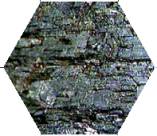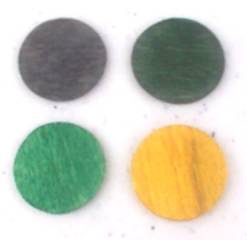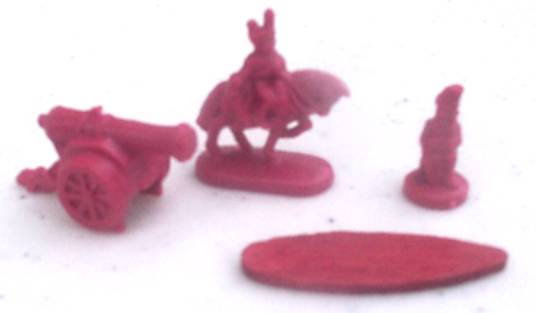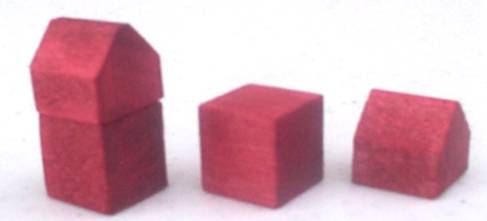Imperial Conquest Rules & Instructions
October 1, 2003
Object of the Game
The object of the game is to defeat all of your opponents by conquering their
towns and cities and destroying all of their units. When a player is eliminated
from the game, the player that eliminated him gains all unused resources the
eliminated player had in his possession.

Terrain
5 terrain types: Water, Food, Ore, Wood, Gold





Recommended Terrain/Resource Hex Frequency
The game comes with 200 hexes and players are encouraged to play around with
different combinations of resources to customize each map and make each game a
unique experience. The frequency of terrains and resources listed below are
suggested ranges to stay within in order to have a balanced game.
Water: 40-60%
Food: 20-30%
Wood: 10-15%
Ore: 10-15%
Gold: 5-10%
Resources
Food – light green resource chips
Wood – dark green resource chips
Ore – gray resource chips
Gold – yellow resource chips

Units
4 unit types: Infantry, Cavalry, Frigates, Artillery

Costs
Inf – 1 food
Cavalry - 1 food, 1 gold
Frigates – 1 ore, 2 wood
Artillery – 2 ore, 1 gold, 1 wood
Movement
Inf – 2
Cavalry – 3
Frigate – 4
Artillery – 2
Capabilities
Inf – Can become a town at any time.
Cavalry – Has selective attack.*
Frigate – Can carry 2 infantry or 1 cavalry or 1 artillery and can go through
isthmus buildings.** Functions as a naval artillery and can shell cities/units
for a one round bombardment with range of 1. Has selective attack. Can only be
killed by other frigates or artillery.
Artillery –Can bombard units and cities with range of 2. Can defend against
other bombardments, both land and sea. Has selective attack. Can kill frigates.
*Owner can choose which enemy piece to kill in battle
**Towns and cities built upon isthmuses of land that separate two bodies of
water, can allow a frigates to pass through at a cost of 1 of the frigate’s
movement points, though by no means can the frigate end its turn on the land
hex. So if a frigate doesn’t have enough movement left to move through the
isthmus, then it has to wait until the next turn.
Buildings
2 building types: Towns & Cities

Costs
Town – 1 inf
City – 1 food, 1 ore, 1 gold, 1 wood
Capabilities
Town – produce units, generate 1 resource per turn based on the resource hex it
sits upon, town defenses provide one extra die on defense for first roll in any
battle
City – produce units, generate 2 resources per turn based on the resource hex it
sits upon, city defenses provide two extra die on defense for first roll in any
battle
All towns/cities have to be a minimum of 2 hexes away from another town/city,
leaving one blank hex between the two.
Combat
If you have >0 infantry, you get to roll 1 die
If you have >0 cavalry, you get to roll 1 die
If you have >0 frigates, you get to roll 1 die
If you have >0 artillery, you get to roll 1 die
All hits are on a 3 or less for the die roll.
Rolls are considered simultaneous, with attacker rolling first, then the
defender rolling, and only then are “hit” units removed from the game.
Retreats
The defender can choose to retreat in lieu of rolling after the attacker rolls
during any round of combat in a battle. The defender may then retreat into any
adjacent hex that is either unoccupied or contains his units.
The attacker can choose to retreat from any battle after any complete round of
combat in a battle instead of continuing the battle. The attacker may retreat
into any adjacent hex that any of his attacking units came from.
Naval Transport
Upon being dropped off from a frigate, units can engage in fighting, but their
movement is considered used up.
Amphibious Assault
No retreat from a purely amphibious assault, though if any nonamphibious units
are engaged, they may all retreat back to the location the nonamphibious units
came from.
Bombardment
Bombardment is where each artillery and frigate can take a 1 one shot at enemy
units and kill on a 3 or a less. The defender can’t shoot back unless there is a
frigate or artillery in that hex. However, frigates only have a range of 1,
while artillery have a range of 2. If the defender does shoot back, it is still
only a 1 round response.
Game Board
The game board would be a giant hex of different sizes for different numbers of
players.
Giant hex for 5 or 6 players of 169 hexes
Semi giant hex for 4 players of 127 hexes
Medium hex for 3 players of 91 hexes
Small hex for 2 players of 61 hexes
Also, the outer perimeter of hexes is always water, allowing any player to build
a city on the shore, build a frigate, and circumnavigate the world.
Game Beginning
Each player would start the game by placing 1 town at their discretion. Each
player goes in turn to place their first town and then the first player places a
second town (but it must be 2 or 3 hexes away from his first). Each player then
goes around again and places his second town. Then a third town is placed using
the same methodology.
Turn Sequence
1. collect income from towns/cities
2. decide what to buy, including cities - set purchases off to one side
3. move units
4. fight battles/build towns
5. construct units, can be done in newly constructed towns/cities, but NOT newly
conquered towns/cities
Trading
Players can make a 3 for 1 conversion to any resource, or of course trade for
even better results.
All the hexes would be shuffled and redealt between each game.
Newly Captured Towns/Cities
Units may not be built in newly captured towns/cities
Player Elimination
A player is considered eliminated from the game only when all of their towns and
cities have been conquered by another player and all of their units are
destroyed.
Battle Examples:
All rolls are on a 6 sided die and are accounted a hit with a roll of 3 or less.
Example 1:
Red attacks Blue
Red: 1 infantry
Blue: 1 infantry in a town
Round 1: Red rolls 1 die, Blue rolls 2 dice (1 for the infantry, 1 for the
defending town)
Red rolls a 5, and Blue rolls a 6, 4 – all misses
Round 2: Red rolls 1 die, Blue rolls 1 die (the defending town only contributes
1 die during the first round of combat)
Red rolls a 2 (a hit), Blue rolls a 5 (a miss)
Red conquers the town, exchanging the Blue town marker for a Red town marker
Example 2:
Red attacks Blue
Red: 4 infantry, 3 cavalry, 2 artillery
Blue: 3 infantry, 2 cavalry, 1 artillery in a city
Round 1: Red rolls 3 dice (1 for each unit type), Blue rolls 5 dice (1 for each
unit type, 2 dice for the defending city)
Red rolls a 2 for his infantry, 1 for his cavalry, and 6 for his artillery (hits
with the infantry and cavalry)
Blue rolls a 4 for his infantry, 5 for his cavalry, 2 for his artillery, and 2,
4 with his city defenses (hits with the artillery and city defense)
Red’s infantry does not have selective attack, and does not choose what it
kills, and so Blue chooses to lose an infantry.
Red’s cavalry does have selective attack, and Red chooses to kill Blue’s
artillery
Blue’s artillery does have selective attack, and Blue chooses to kill one of
Red’s artillery
Blue’s city defenses does not have selective attack, and Red chooses to lose an
infantry
Round 2:
Red: 3 infantry, 3 cavalry, 1 artillery
Blue: 2 infantry, 2 cavalry in a city
Red rolls 3 dice (1 for each unit type), Blue rolls 2 dice (1 for each unit
type, and the city defenses only contributes 2 dice during the first round of
combat)
Red rolls a 6 for his infantry, 3 for his cavalry, and 2 for his artillery (hits
for the cavalry and artillery)
Blue rolls a 2 for his infantry, and a 1 for his cavalry (both hits)
Red’s cavalry and artillery both have selective attack and so Red chooses to
kill both of Blue’s cavalry
Blue’s infantry does not have selective attack, and Red chooses to lose an
infantry
Blue’s cavalry does have selective attack, and Blue chooses to kill one of Red’s
artillery
Round 3:
Red: 2 infantry, 3 cavalry
Blue: 2 infantry in a city
Red rolls 2 dice (1 for each unit type), Blue rolls 1 die
Red rolls a 1,3 (both hits)
Blue rolls a 2 (a hit)
Red kills both of Blue’s infantry, Blue kills 1 of Red’s infantry
Red conquers the city, exchanging the Blue city marker for a Red city marker
Example 3:
Red attacks Blue
Red: 2 artillery which are 2 hexes away
Blue: 1 infantry, 1 cavalry in a town
Red chooses to bombard with his artillery
Round 1: Red rolls 1 die for his first artillery, and rolls a 3 (a hit)
Blue has no artillery in the attacked hex with which to respond
Red’s artillery does have selective attack, and Red chooses to kill Blue’s
cavalry
Round 2: Red rolls 1 die for his second artillery, and rolls a 2 (a hit)
Blue has no artillery in the attacked hex with which to respond
Red’s artillery kills Blue’s infantry
The town is now empty
Round 3: Red decides to move his two artillery units into the town and conquer
it.*
Blue rolls 1 die for his town defenses and rolls a 2 (a hit)
Red loses one of his artillery
Red conquers the town with the remaining artillery, exchanging the Blue town
marker for a Red town marker
*Red did not have to attempt to conquer the town, but could have kept his
artillery where they were
Example 4:
Red attacks Blue
Red: 1 frigate, 2 infantry, which are on the frigate
Blue: 1 infantry, 1 artillery in a town
Round 1: Red rolls 2 dice (1 for each unit type), Blue rolls 3 dice (1 for each
unit type, and 1 for the town defenses)
Red rolls a 3 with the frigate, and a 4 with the infantry (1 hit for the
frigate)
Blue rolls a 5 with his infantry, 2 for his artillery, and a 1 for his town
defenses (1 hit for his artillery and town defenses)
Red’s frigate does have selective attack, and Red chooses to kill Blue’s
artillery
Blue’s town defenses cannot kill frigates and so Red loses an infantry
Blue’s artillery does have selective attack and can kill frigates, and so Blue
chooses to kill Red’s frigate
Round 2:
Red: 1 infantry
Blue: 1 infantry
Red rolls a 2, and Blue rolls a 3 (both hits)
Both remaining units are killed, but the town is still controlled by Blue
www.viktorygame.com








